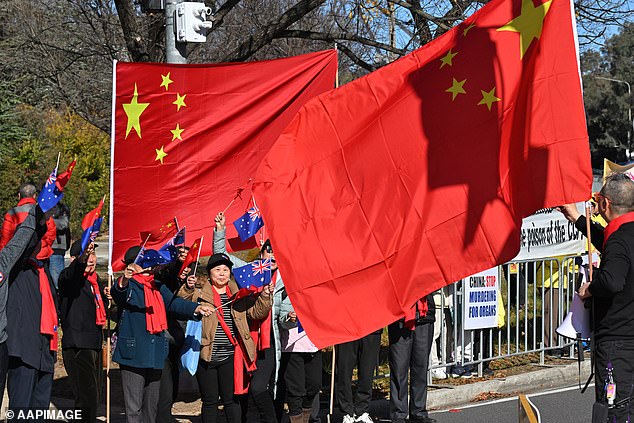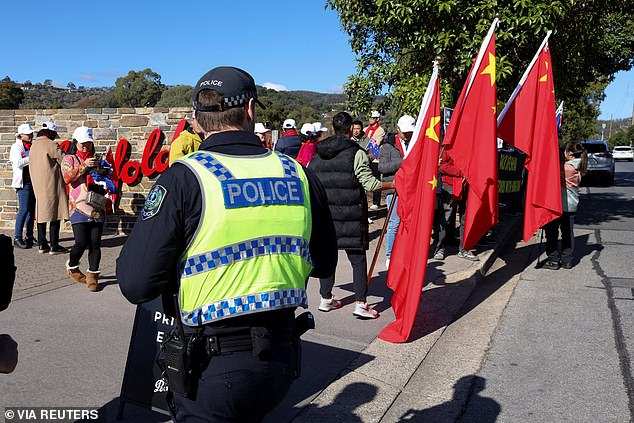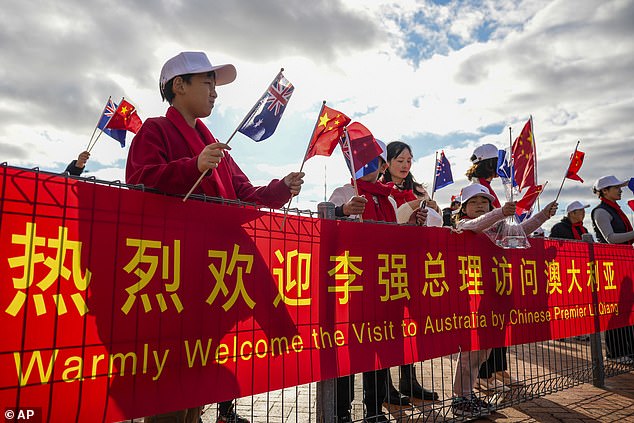China’s second-most powerful leader to be welcomed at Canberra
Pro-China protesters have flooded the lawn at Parliament House and blocked peaceful Tibetan activists as Anthony Albanese prepares to meet with China’s second most powerful leader.
Tensions between rival protesters escalated on Monday morning ahead of Prime Minister Li Qiang’s state visit to Canberra.
Peaceful supporters of Tibet, a predominantly Buddhist region in China’s far west, were swarmed by counter-protesters who unfurled huge Chinese and Australian flags to hide them from view.
Some protesters carried huge flags uniting the Chinese and Australian flags, while Tibetan sympathizers struggled to keep their banners aloft.
At one point, a scuffle broke out when a man fell to the ground and downed a raised loudspeaker as a heavy police presence observed the standoff.
One observer claimed that ‘people carrying Chinese flags were brought in on buses and paid to ‘welcome’ Chinese Premier Li Qiang.
Tensions between rival protesters escalated on Monday morning ahead of Prime Minister Li Qiang’s state visit to Canberra (photo: Prime Minister Qiang with Prime Minister Anthony Albanese)
Another protester held a sign reading “Human rights: not for sale,” calling for a free Tibet.
Tibet’s spiritual leader, the Dalai Lama, lives in exile in India and is seen as a separatist threat by Chinese authorities, who exercise tight control over the region.
Albanese will receive the Chinese Prime Minister for a four-day state visit to Canberra.
Top of the Australian leader’s agenda will be removing persistent trade barriers and pushing for security and human rights issues.
Premier Li Qiang declared ties were “back on track” after “twists and turns” when he arrived this weekend – welcome news for the lobster fishery and remaining beef producers under restrictions.

Peaceful supporters of Tibet, a predominantly Buddhist region in China’s far west, were swarmed by counter-protesters who unfurled huge Chinese and Australian flags to hide them from view

At one point, a scuffle broke out when a man fell to the ground and downed a raised loudspeaker as a heavy police presence observed the standoff.
Beijing’s second most powerful leader will hold talks with Mr Albanese on Monday as part of an annual leaders meeting in the capital, followed by a state lunch with politicians, business representatives and community leaders.
A trip to Australian resource power Western Australia will form the final part of the visit, which comes amid some clouds hanging over the two countries’ broader relationship, even as many trade restrictions have been lifted.
China imposed sanctions on $20 billion worth of Australian products in 2020 after the former coalition government called for an independent investigation into the origins of the COVID-19 pandemic.
Prime Minister Li’s visit is the first by a Chinese premier to Australia in seven years and comes after a period of turbulence for the country’s largest trading partner, while recent military incidents in international waters have threatened the diplomatic thaw.
Foreign Minister Penny Wong said on Sunday that Canberra would put strong pressure on Australian interests after she was asked whether she would take up the case of Australian writer Yang Hengjun, who is languishing ill in a Chinese prison.
The remaining trade bans are expected to be lifted within weeks, but exporters may wonder whether they will have to deal with them again.
“The question then becomes how long can we be confident that there will be trade restriction-free exports to China,” said Dr Benjamin Herscovitch, a researcher at the Australian National University’s School of Regulation and Global Governance.
“It is always possible that if Beijing commits a serious violation, it could throw the hammer at Australian exporters again,” he told ABC Saturday Extra.

One observer claimed that ‘people carrying Chinese flags brought in on buses and paid to ‘welcome’ Chinese Premier Li Qiang

Some protesters carried huge flags uniting the Chinese and Australian flags, while Tibetan sympathizers struggled to keep their banners aloft
“The battle here will be one of a range of specific policy areas where Beijing seeks to make progress and gain additional concessions from Canberra.”
“Canberra will try to hold the line, not to give Beijing too much, but also not to anger Beijing again and push Beijing to reimpose trade restrictions.”
Canberra has taken a tough stance on technology cooperation since Huawei, the Chinese telecoms giant, was excluded from the national 5G network rollout over security concerns.
“Canberra says, look, we want trade restrictions to go away and we want high-level diplomacy to be restored, but we’re not interested in deeper cooperation in science and technology because we might see that as a threat from an Australian point of view for safety,” said Dr. Herscovitch.
Treasurer Jim Chalmers recently ordered five China-linked funds to reduce their stakes in rare earth mining company Northern Minerals.
Critical minerals are a key part of the Prime Minister’s Future Made in Australia initiative, amid long-standing global concerns about Chinese control of much of production.
Essential minerals are used in many ways in the energy transition: from wind turbines to batteries.
